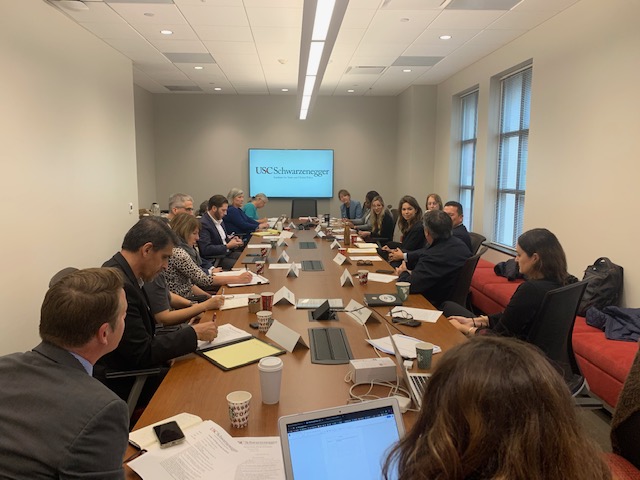On December 4th the Schwarzenegger Institute hosted an energy storage roundtable to discuss ways to accelerate the adoption of energy storage systems in California. The roundtable was led by Environmental Policy Director Fran Pavley and was attended by nearly 20 energy and policy experts from across California.
Senator Pavley gave the opening remarks and focused the timely conversation on finding short-term and mid-term incentives, policies, and programs to scale up small-scale energy storage across California. She emphasized California’s need to find solutions as it works toward securing 100% clean and resilient energy, especially in high fire risk areas that have seen an upsoar in wildfire frequencies.
Bernadette Del Chiaro, Executive Director of the California Solar & Storage Association (CALSSA), began the discussion by mentioning the impact that black outs and wildfires have had in redefining energy resiliency and reliability as a personal and urgent need. “Power shut-offs are an unacceptable disruption to people. There is a real human need for reliable electricity,” she said. Del Chiaro also urged the group not to focus on immediate triage, but rather focus on larger goals.
Carla Peterman, Senior Vice President of Regulatory Affairs at Southern California Edison (SCE), reiterated that distributed solar and storage will be necessary in the future to meet California’s clean energy goals. Peterman also indicated that while 27% of SCE’s service areas are in high fire risk areas, only 2% of their customers have been impacted by power shut-off events. She also called for front of the meter microgrids that can support a significant number of a city’s essential facilities and listed the San Jacinto Unified School’s solar and storage system as an exemplary pilot program.
The discussion proceeded to discuss some of the existing programs to accelerate renewable energy and storage and the areas where they need improvement. California’s Self-Generation Incentive Program (SGIP), for example, provides incentives to support existing, new, and emerging distributed energy resources, including advanced energy storage systems. While SGIP has impactful components such as the potential to generate 550MW of power and it has allocated 25% of its budget for low-income communities, there are areas of improvement that could speed up market transformation. One of those issues is the year-long wait time it takes to receive a rebate through the SGIP program. “When you buy an electric vehicle in a state rebate program you get a check back, for a battery you need to jump through hoops and the uncertainty is damaging to the market,” Brad Heavner, CALSSA Policy Director.
In addition to improving the SGIP program, the roundtable participants called for an extension of the federal solar Investment Tax Credit (ITC). Anne Hoskins, Chief Policy Director at Sunrun, stated the importance of ITC for California’s renewable energy growth, especially during a time when the Trump administration is gutting clean energy policies and imposing high tarrifs on solar panel imports. The ITC is set to phase down December 31, 2019. Hoskins noted her concern for the lack of political will and urgency to keep such federal policies alive.
On a more local level, Lauren Faber-O’Connor, Chief Sustainability Officer for City of Los Angeles, updated the group on LA’s Green New Deal and assured that the Plan’s zero carbon buildings and zero emissions electricity grid goals will provide opportunities to grow a skilled workforce in the clean energy sector and further accelerate the adoption of energy storage systems. She also mentioned how the LA region’s deployment of energy solutions has the potential to create a rippling effect at the state and national level.
Jason Rondou, Manager of Strategic Development and Projects at the Los Angeles Department of Water and Power (LADWP), followed up and suggested the LA region conduct an optimization study on where to best allocate resiliency facilities. Such information would be critical in implementing battery storage systems in every school that already has solar, as was suggested by Carla Peterman and Brad Heavner.
A longer term goal, also suggested by Brad Heavner, was creating a statewide policy similar to Governor Schwarzenegger’s successful Million Solar Roofs Inititative, but with the endgoal to install a million small-scale energy storage systems throughout California.
Thinking big and acting local was a common theme throughout the conversation. While the solutions to scale up energy storage varied, all participants were in agreement that the time for aggressive, innovative polices is now.
“There is more risk in not doing anything than there is in taking bold action,” said Katie McCormack, West Policy Program Director at the Energy Foundation

